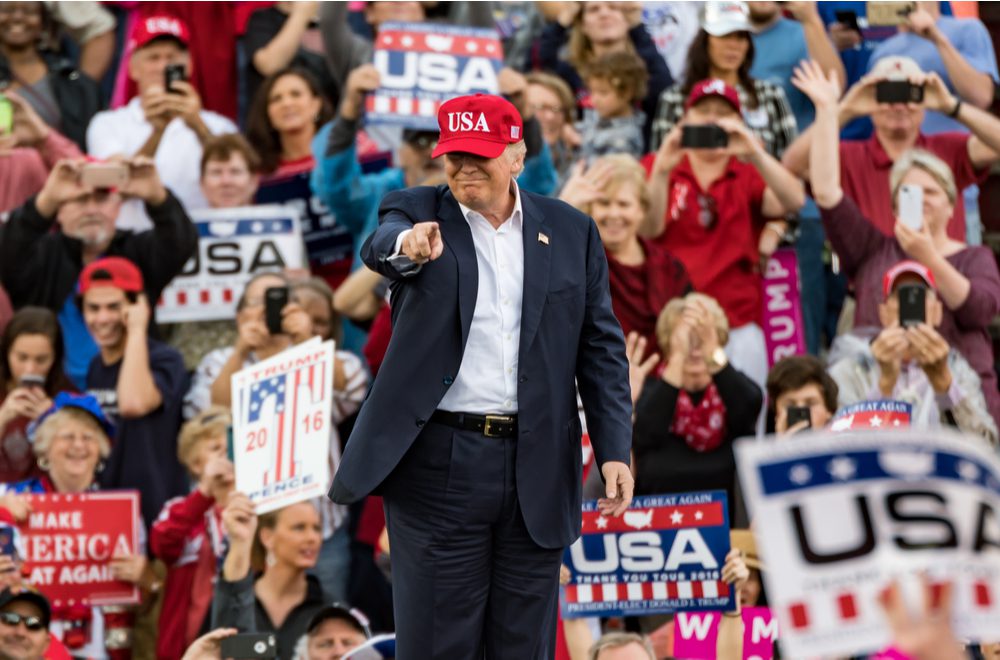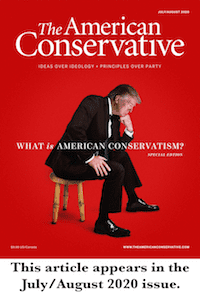Why Not Progressive Conservatism?

The dwindling band of NeverTrumpers fondly imagines that Republicans will snap back to the former party of beautiful losers when Trump departs the scene. We’re the people with ideas, they say, and we have ownership rights over Republican thinking. But they’re merely a rag-tag bunch of neocons, libertarian purists, prissy mugwumps, and party apparatchiks who have little in common apart from their detestation of Trump.
On both right and left, American politics has degenerated into a brain-dead battle over personalities, not principles. Which raises the question of where we’ll be when Trump leaves the scene. The Alexandrine poet C.P. Cavafy wrote about what happens when threats just go away. People had been terrified by the thought of a barbarian invasion. Except one day everyone realized that the barbarians wouldn’t show up. “Now what’s going to happen to us without barbarians? Those people were a kind of solution.”
A real solution will come, however, when we recognize that the principles which guided the Trump campaign will remain after Trump, and that they represent a form of progressive conservatism. That might seem an oxymoron. It’s not. Burke would have recognized the need for policies that look forward to posterity while conserving what we’ve learned from our ancestors. So would Disraeli and so, obviously, would T.R. Roosevelt. And that’s how the Trump campaign cracked America’s electoral code in 2016.
Before Trump, the Republican establishment had seen politics along a single left-right economic divide, where the goal was to check off every right-wing box. What Trump showed, however, is that there’s more going on than a single economic axis can capture. Along a different axis, voters can be divided according to their views about a variety of other issues: a classless versus a class society, honesty versus public corruption, and nationalism versus globalism. Grouping all such concerns together, our politics can be portrayed along two axes, economic and non-economic, according to the preferences of two-dimensional men who vote for two-dimensional progressive conservatism. This divided voters into four quadrants, and the winning one was left-wing or middle of the road on economics but right-wing on social issues. Those voters went three to one for Trump.
That’s the sweet spot in American politics, but Trump’s first term represents an Unfinished Revolution. The 2017 tax bill left in place the loopholes of a 75,000-page tax code. Trump had campaigned on a pledge to replace Obamacare with something “beautiful,” but that didn’t happen. A modest start was made with regulatory cutbacks, but what happened was simply a reduction in their rate of growth.
The Trump agenda was stalled by a groundless story about Russian collusion and by a Republican Congress that even now hasn’t fathomed why the forgotten Americans supported him. But Trump’s issues haven’t gone away, and they’ll continue to define American presidential politics after Trump, be that in 2021 or 2025. These are, 1) The defense of the American Dream, the idea of a country in which whoever you are, wherever you live, you can get ahead and your children will have it better than you did; 2) The attack on public corruption; and 3) American nationalism.
The American Dream
We’ve always imagined that, unique in the world, America was the place where everyone could get ahead, the place where “each man shall be guaranteed the opportunity to show the best that there is in him,” as T.R. Roosevelt put it. Obama’s policies had given the country stagnant growth and a jobless recovery, but he seized on the issue and voters felt that he had their back. By contrast, Romney came across as the boss about to hand you the pink slip.
The issue resonated with voters. The evidence had begun to mount that we were unequal and immobile. When asked, we told pollsters that we thought that the American Dream was a thing of the past and had departed to more mobile countries. To anyone who was listening, to anyone who took pride in America, that augured a revolution in our politics, but the old Republican Party ignored the message. In a firing squad, it’s only the prisoner who doesn’t hear the click of the rifles.
Trump made these his issues in 2016, and a Republican Party that seeks to repeat Trump’s winning strategies will take the issues of inequality and immobility away from the Democrats by telling voters that it’s their policies that have held the forgotten Americans back. Failing schools, broken universities, a wretched immigration act, a regulatory state on steroids—all these are backed by Democrats for the benefit of left-wing elites, but they’ve taken economic opportunities away from the rest of us and turned America into an aristocracy.
In 1911, T.R. Roosevelt argued that progress requires the destruction of unearned and unjustified privilege. Today, much more than then, an overlord clerisy dominates our culture, universities, and laws, and (as Charles Taylor has noted) labels as barbarians anyone who objects. By opposing them, progressive conservatives will restore the American Dream.
Corruption
When Trump said he’d drain the swamp, we knew what he meant. It wasn’t just the ethically challenged Clintons. It was also “the comfortable politicians looking out for their own interests. It’s the lobbyists who know how to insert that perfect loophole into every bill. It’s the financial industry that knows how to regulate their competition out of existence. The insiders also include the media executives, anchors and journalists in Washington, Los Angeles, and New York City, who are part of the same failed status quo and want nothing to change.”
Republicans had given the issue of public corruption to the Democrats. Elizabeth Warren campaigns on it, and it’s what drives progressives into the arms of the Democrats. A Trumpian party will be both progressive and conservative, and will snatch the issue from the Democrats by reminding voters that it’s they who are the party of corruption.
The Trump administration has thus far ignored the issue, or even abandoned it by firing inspectors general. But after Trump the Republican Party needs to take it on by closing the revolving door between Congress and K Street, and by enacting tough lobbying reform measures. The progressive conservative will take up Roosevelt’s call to free our government “from the sinister influence or control of special interests.”
Nationalism
Trump has consistently conveyed the message that we shouldn’t divide ourselves on the basis of race or sex. That’s what American nationalism means. In other countries, nationalism might be based on a common culture or religion. Not us. What makes Americans Americans are the liberal values to be found in the Declaration and the Bill of Rights. American nationalism is liberal nationalism.
Democrats have abandoned our liberal heritage, however. For all that they complain about Trump’s racism and sexism, it is the Democrats who do that, with their identity politics. Perversely, they try to make anti-racism look like racism. If they want to dig that hole, best to simply stand by and watch. What we don’t need are people who go on about right-wing Hungarian nationalism. That’s not us.
The Democrats also lack a sense of solidarity with their fellow Americans and don’t appear to care that their policies hurt American workers. By contrast, Trump embraced the voters who had lost their jobs and took aim at globalists who were indifferent between Americans and foreigners. In accepting his party’s nomination, he said that “the most important difference between our plan and that of our opponents, is that our plan will put America First. Americanism, not globalism, will be our credo.”
Nationalism has a gravitational force that pulls one leftward on social welfare policies, which is why the Trump agenda is both nationalistic and progressive. The new breed of nationalists hasn’t noticed, but nationalism takes two very different forms. Vertical nationalism desires its country’s glory, its preeminence over that of other countries. Horizontal nationalism rests on a sense of kinship to and fraternity with fellow citizens, and that in turn implies free market policies that create the economic conditions that provide jobs (with a better understanding of economics than anyone possessed in 1911), as well as a generous social safety net for those who can’t work.
Historically, Republicans have been the party of vertical nationalism, and Democrats the party of horizontal nationalism. That kind of nationalism they left to the Democrats, to people like FDR. What was remarkable about the 2016 Republican victory was that, almost for the first time, a presidential candidate ran on a platform that united the two strands of nationalism.
If that’s what makes the progressive conservative progressive, he is also a conservative who thinks that the government should suppress riots forcefully, that the police are owed our presumptive support, and that nothing good was ever born out of anarchy. He thinks that we’re self-deceived about our goodness and that a sense of justified anger too often serves to excuse crimes. 
After Trump, after the bluster and the braggadocio, these ideas will remain, and progressive conservatism will inform the policies of a successful Republican Party.
F.H. Buckley is a professor at Scalia Law School and the author of American Secession: The Looming Threat of a National Breakup (Encounter, 2020).
Related: Introducing the TAC Symposium: What Is American Conservatism?
See all the articles published in the symposium, here.